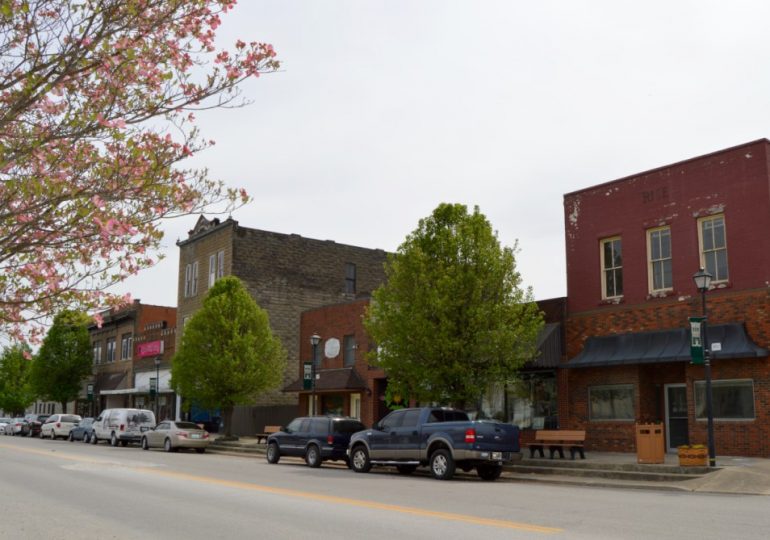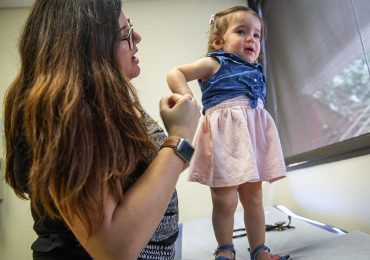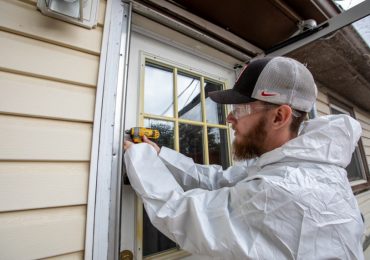An unlikely collaboration between a Kentucky coalfield county and Kentucky’s largest city began when a former high school English teacher, Megan Downey, walked into the Lawrence County courthouse in Louisa in August.
Inspired by a personal desire to find ways to tackle the impacts of climate change, Downey had launched a nonprofit called The Solar Collaborative last year in Virginia dedicated to helping Appalachian communities transition to renewable energy.
She had been pitching an idea to local governments across Eastern Kentucky: Seek some of the billions in federal funding up for grabs in the Solar for All competition. Through the competition, the U.S. Environmental Protection Agency plans to invest $7 billion through 60 grants to states, local governments, nonprofits and tribal governments to “increase access to affordable, resilient, and clean solar energy for millions of low-income households.” The money comes from the Inflation Reduction Act’s Greenhouse Gas Reduction Fund.
When Downey talked with Deputy Judge-Executive Vince Doty about the opportunity, he agreed “within minutes” to sign up.
“He’s the biggest advocate, I think, in the whole region for this type of project,” Downey said. “A lot of low-income communities don’t have access to that economic savings that’s associated with solar, and so it’s just one more way in which a wealth gap is continuing to increase.”
Doty brought other Eastern Kentucky counties on board for an application to the competition; judge-executives in Lawrence, Johnson, Martin, Floyd, Pike, Boyd, Greenup counties all wrote letters of support. After learning they had both submitted letters of intent to apply for the federal funding, the mountain counties teamed up with Louisville’s government to submit a unified application that could provide affordable access to solar energy for thousands of low-income homes in Kentucky from its largest cities to its rural Appalachian counties.
It’s one of two competing applications from Kentucky. The other was submitted by the Kentucky Energy and Environment Cabinet; solar advocates say it could be a significant boost for the use of residential solar across the state.
Advocates argue more distributed solar, for example via solar panels on rooftops, could mean utility bill savings for Kentuckians and a curbing of greenhouse gas emissions connected to Kentucky’s fossil fuel-reliant electricity grid.
For Doty, seeking funding for solar was foremost about easing the financial burden of his constituents in a region that faces continued economic challenges from the decline of the coal industry. Lawrence County is one of 20 Eastern Kentucky counties served by electric utility Kentucky Power, which has the highest monthly residential utility bills in Kentucky, according to a state analysis.
“We always try to put our citizens first,” Doty said. “If there’s a chance that we can save somebody $300 a month off their electric bill, that’s worth trying for.”
Solar low-income households, ‘resilience hubs’ and job training
Both the Louisville-Eastern Kentucky and state government proposals are wide in scope, highlighting specific ideas for how to use tens of millions of dollars in federal funding. Both applications could mean integrating solar energy into thousands of homes, whether through direct ownership of rooftop solar installations or better access to existing or planned community solar projects.
The Louisville-Eastern Kentucky application is asking for $150 million to be spent over five years, proposing:
A zero to low-cost forgivable loan program geared toward having low-income households own small solar installations or receive energy efficiency upgrades. For example, homeowners applying to the loan program who are below 80% of the area median income could have an entire loan forgiven for a six-kilowatt solar installation; half of the loan could be forgiven for property owners renting to Kentuckians below 80% of the area median income.
Turn community centers in areas prone to natural disasters into “resilience hubs” equipped with solar power and electric battery storage for times of power outages.
Build a workforce to deploy residential solar by creating training programs, building on already existing programs in Kentucky’s community and technical college system.
Downey said Doty had advocated in a number of meetings as the Louisville-Eastern Kentucky application was being developed that it was a “non-negotiable” that Kentuckians should own the solar installations themselves
The application anticipates, if awarded funding, at least a 20% energy bill reduction for approximately 7,300 households in Kentucky taking part in the proposal. Households that ultimately receive a six-kilowatt solar installation for free could see energy bill reductions up to 50%, according to the application.
“If you put solar on your home, you immediately have benefits economically from the savings that you garner. It also increases the value of your home,” Downey said. “So this has the potential for a really significant impact if you look at it over 25 years as far as wealth generation goes.”
The Louisville-Eastern Kentucky application estimates the results of the funding would add another approximate 44 megawatts of distributed solar power onto Kentucky’s grid. That would increase distributed solar in the state by about 70%, with 63.5 megawatts of distributed solar already in Kentucky.
The application also estimates about 1,300 “green jobs” will be created through the proposed solar investment. Steve Ricketts, the board chair of the advocacy group Kentucky Solar Energy Society, said while construction work associated with larger, utility-scale solar projects is temporary, ending once the project is completed, those workers also can work on installing solar in their own communities.
“They can be working on homes in their own town, they can be working on businesses and around town. So the two are incredibly complementary, and, frankly, have to go together to make it all work,” Ricketts said.
Sumedha Rao, the executive director of Louisville Metro Government’s Office of Sustainability, said the estimates of solar power added, households helped and renewable energy jobs created through the funding proposal are somewhat conservative and that the impact of the grant could be even more.
Given that Kentucky has historically relied on fossil fuels, she said, a transition to renewables can be a “scary proposition” for some Kentuckians. But she believes the Solar for All grant competition has a lot of upside with helping the state transition economically.
“We really feel like this is something that can have a massive impact for years to come,” Rao said.
Solar installations for rebuilt homes, ‘solarize’ campaigns and community solar
The Solar for All application submitted by state officials leads with its own idea of how residential solar can be deployed across the state, particularly in areas hit by devastating floods and tornadoes in recent years.
Requesting $100 million from the Solar for All competition, one of the state’s proposals is to put residential solar and an electricity battery storage system on 850 “disaster recovery” homes that could result in 70% utility bill savings for each home — or up to $1,000 in annual bill savings per home — over the course of 20 years.
For Kenya Stump, the executive director of the state’s Office of Energy Policy, eliminating most of the energy bills is just one way to help people recovering from natural disasters who may have lost every material thing they own.
“If they can live in a home from here on out that is more resilient, that also has the burden of that kind of cost is no longer there — shouldn’t we kind of strive for that?” Stump said.
The application also proposes to help increase solar access for low-income Kentuckians, support housing nonprofits in creating energy-efficient housing, develop residential solar in cities and boost the state’s solar deployment workforce in several ways: Create subsidies and carve-outs to help Kentuckians participating in the Low-Income Home Energy Assistance Program, or LIHEAP, take part in existing and planned “community solar” projects to cut residential utility bills by about 20%.
Add solar power and electricity battery storage onto about 1,500 homes that already have energy efficiency upgrades, such as households that have participated in Weatherization Assistance Program.
Develop “Solarize” campaigns to promote residential solar in Kentucky cities including Paducah, Owensboro, Henderson, Bowling Green, Lexington and Ashland.
Create 1,500 “work-ready” scholarships and provide funding to community and technical colleges funding to create solar deployment training programs.
Stump said in many instances low-income Kentuckians live in homes that are old and energy inefficient, leading to higher energy usage and subsequently higher utility bills. She said by enrolling LIHEAP recipients in community solar programs — such as ones offered by East Kentucky Power Cooperative and Louisville Gas and Electric and Kentucky Utilities (LG&E and KU) — they can get a direct credit on their bill and get more value from the utilized renewable energy.
“The energy regardless of the source will just still leak out” of poorly insulated, inefficient homes, Stump said. “We also hope that this will incentivize the growth of more municipal and utility community solar offerings that would be eligible to have LIHEAP carve-outs as well.”
Some stakeholders involved in the Louisville-Eastern Kentucky application, while supportive of community solar projects in general, were skeptical of using Solar for All funds on such projects out of concerns that some community solar models, specifically LG&E and KU’s “Solar Share” program, subsidize an asset of an investor-owned utility with taxpayer funds.
Stump said while stakeholders may wish some existing community solar projects were designed differently, it’s what is currently offered by Kentucky utilities and “can provide some benefit” to low-income Kentuckians that haven’t been able to take advantage.
The two Kentucky applications submitted to Solar for All do align on ways to boost the workforce needed to install residential solar on homes, though Stump added that developing a renewable energy workforce needs to be paced with the deployment of solar.
“That’s our greatest challenge is to make sure we get the timing right so that it aligns with the deployment of projects. We don’t want to give someone hope, and then there not be any work,” Stump said.
For Stump, the Solar for All competition is just one federal program and incentive among many that will ultimately “shift and transform our energy landscape.”
No guarantee both applications will be awarded
Lane Boldman, the executive director of the environmental advocacy group Kentucky Conservation Coalition, believes both applications are “really solid” but points out the federal government is only giving out 60 grants. Competition for the grants is stiff: More than 30 states have submitted notices that they’re applying along with a number of local governments and nonprofits across the country.
Lawrence County and Louisville decided to collaborate, in part, to increase the chances that their Solar for All application would get awarded. The stakeholders with Lawrence County and Louisville also tried unsuccessfully to unify their application with the state’s proposal.
Boldman said a big question became if a single grant application could ask for enough funding to cover all of the “great ideas” being proposed for the competition.
“The decision really was that it was better to keep them as two separate applications,” Boldman said. “I have to say that I think both grants are very strong and deserving, and so we just have to wait and see what the federal government decides.”
‘Massive’ federal solar investment could mean big utility savings in Kentucky coal country is an article from Energy News Network, a nonprofit news service covering the clean energy transition. If you would like to support us please make a donation.
Leave a comment









